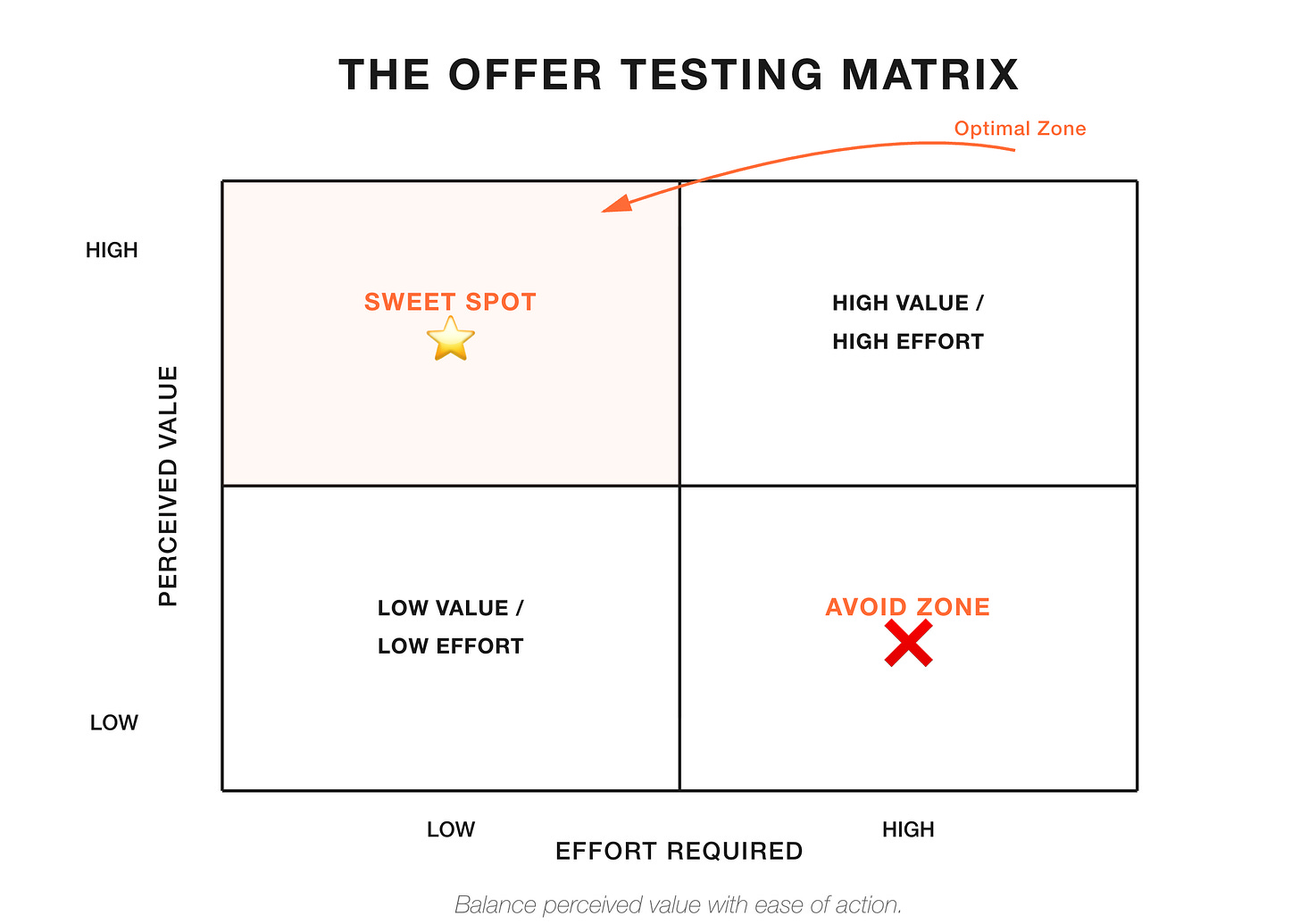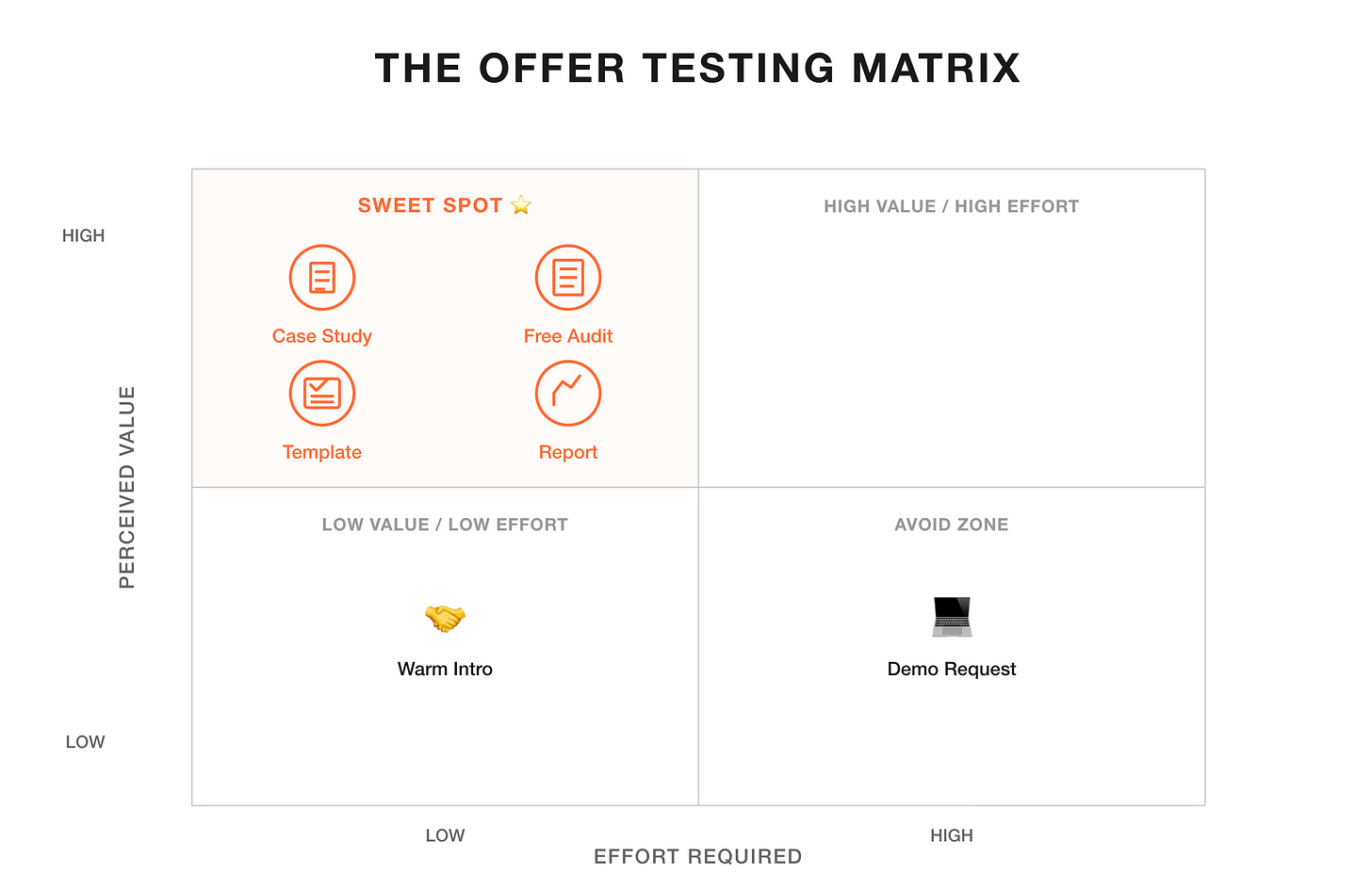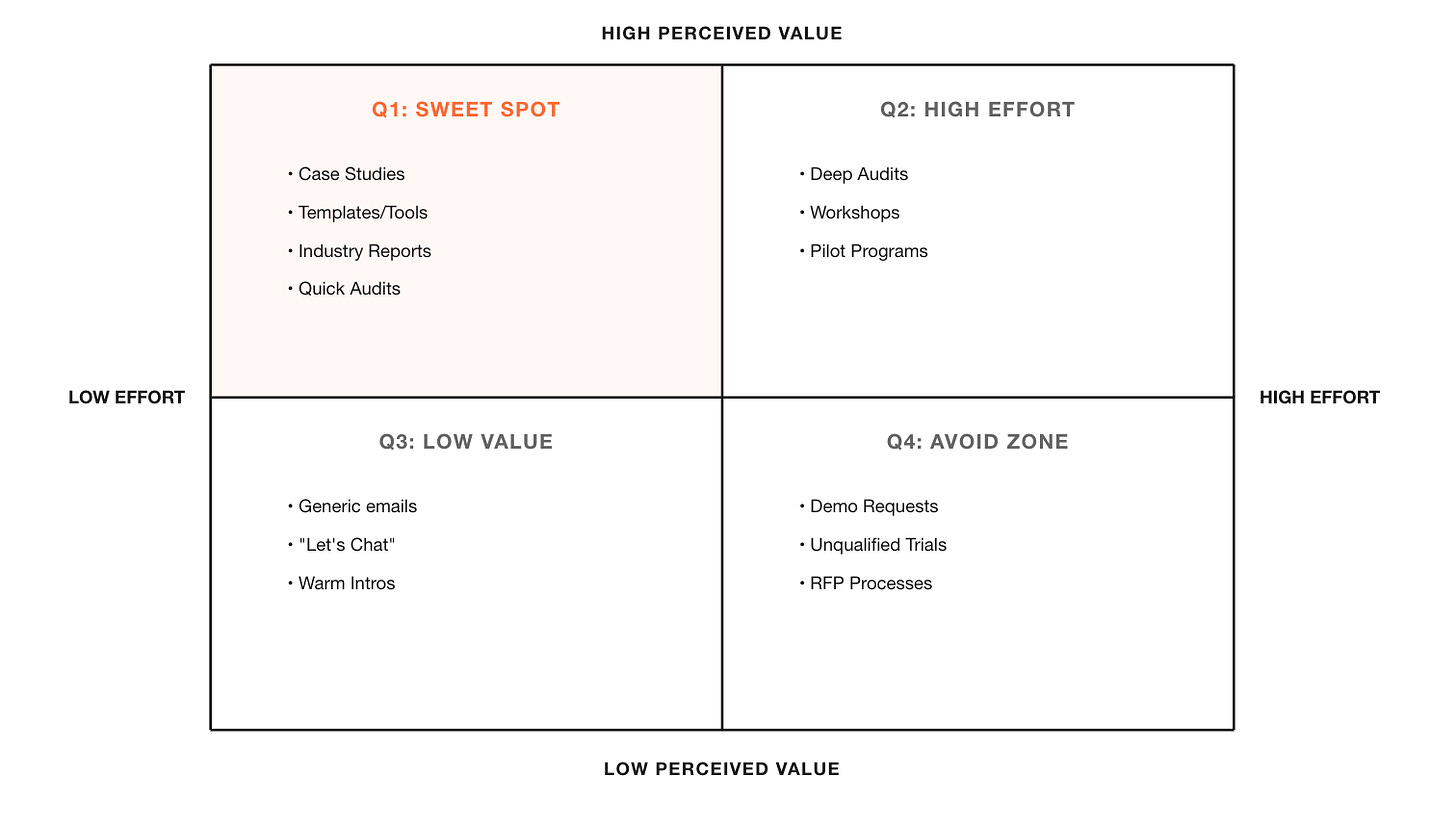The Offer Testing Matrix: 6 B2B Hooks That Convert Cold Prospects into Pipeline
Learn the psychology behind six high-converting offers: personalized case studies, free audits, tool gifts, and industry reports. Master the value-versus-effort decision to evaluate every cold mail.
What we’ll cover below
🎯 Core Framework
The 2x2 Offer Testing Matrix that’s generating 2-4x better cold outreach conversions
Complete psychological breakdown of why prospects say yes or no to cold offers
Decision formula: How prospects calculate ROI vs. Effort vs. Risk in real-time
📊 Six Offer Types Analyzed
Demo Requests - Why they fail cold (and when they work)
Free Audits - The Q1 workhorse driving consistent conversions
Personalized Case Studies - Highest-converting offer with 50%+ better performance
Tool/Template Gifts - Reciprocity triggers generating disproportionate returns
Industry Reports - Authority signals for problem-aware prospects
Warm Introductions - The variable performer (context-dependent)
⚡ Use Immediately:
Positioning templates for each offer type (copy-paste ready)
ICP-specific offer matching framework (Early-Stage, Growth, Enterprise)
Multi-touch offer ladder sequence (6.3% cold-to-demo conversion path)
Behavioral triggering logic (engagement-based offer progression)
💾 Bonus Downloads - Playbooks and Prompt Systems:
Complete Offer Testing Playbook (downloadable framework)
11-prompt AI library for scaling personalization
4-week implementation roadmap (Foundation → Launch → Analyze → Scale)
Advanced strategies: Offer ladders, behavioral triggers, segment optimization
Most B2B teams optimize the wrong variables in cold outreach.
They spend months testing subject lines, refining email copy, and perfecting personalization… all while ignoring the single biggest driver of conversion.
The typical optimization journey looks like this:
Test subject lines (12+ variants over 3 months)
Refine value propositions and body copy
Add deeper personalization (company research, pain points, mutual connections)
Optimize send times (Tuesday-Thursday, 9-11am patterns)
Increase volume (hire more SDRs)
Result: Marginal improvements. Maybe 5-15% better performance after months of effort.
But what if the problem isn’t how you’re asking… it’s what you’re offering?
The 2x2 Model: Value vs. Effort
Lately, I’ve been analyzing dozens of cold outreach campaigns and started noticing a consistent pattern.
Some offers convert 3-4x better than others, even when the messaging and targeting are nearly identical.
It got me thinking: what if we could map these offers on a simple 2x2 matrix, with Perceived Value on one axis and Effort (or friction) on the other?
The hypothesis is straightforward:
High perceived value, low effort offers (the “sweet spot”) should outperform everything else
Low value, high effort offers likely land in the “avoid zone”
Once plotted, each offer type naturally falls into one of four quadrants… from deep audits and workshops (high effort) to quick wins like templates, reports, or light audits (lower effort, high value).
The early takeaway: Offers that hit the “Sweet Spot” consistently convert 2-4x better than those in the “Avoid Zone.”
Why? Because they balance perceived value with ease of action… reducing risk while still triggering the buyer psychology that drives decisions.
Here is a list of all offers that i have analyzed…
The 6 Offer Types: Complete Breakdown
OFFER TYPE #1: DEMO REQUEST (The Baseline)
Quadrant: Q4 (Avoid Zone for cold, acceptable for warm leads)
Best For: Warm inbound leads who specifically requested a demo
Why Demos Fail in Cold Outreach
When you ask for a demo in cold outreach, prospects unconsciously calculate:
Perceived ROI: Low
Value proposition is vague (”see our product,” “learn how we can help”)
No tangible outcome promised
Requires trust before any value delivery
Effort Required: HIGH
30-60 minute time commitment
Scheduling friction (finding time, calendar coordination)
Preparation burden (need to know what to ask, bring stakeholders)
Synchronous interaction (must be present, can’t multitask)
Risk Perceived: HIGH
Pitch trap risk: High probability this is just a sales pitch
Reputation risk: If demo is bad, I wasted colleagues’ time
Obligation created: Now I’m in their pipeline, follow-up pressure
Opportunity cost: Could be doing higher-value work
Decision Formula Result: ROI (Low) < Effort (High) + Risk (High) = NEGATIVE VALUE → NO
When Demo Requests Actually Work
✅ Warm inbound leads (prospect specifically requested demo)
✅ Referral leads (trusted introduction reduces risk)
✅ Re-engagement campaigns (past prospects who showed interest)
✅ Late-stage prospects (already evaluated alternatives, ready to buy)
How to Optimize Demo Offers (if you must use them)
BAD: “Want to book a 30-minute demo?”
Vague value
Generic ask
High commitment
BETTER: “Want a 15-minute walkthrough showing exactly how to solve [specific problem]?”
Specific outcome
Lower commitment
Problem-focused
BEST: “Based on [specific observation about their situation], I put together a 20-minute custom demo showing 3 ways to [specific outcome]. Interested?”
Personalized
Tangible promise
Value-first framing
OFFER TYPE #2: FREE AUDIT/ASSESSMENT (The Q1 Workhorse)
Quadrant: Q1 (Sweet Spot)
Best For: Solution-aware prospects evaluating options
Why Audits Work
Perceived ROI: HIGH
Specific, personalized insights into THEIR situation
Expert diagnosis (authority positioning)
Tangible deliverable (scorecard, action plan)
Valuable whether they buy or not
Effort Required: MEDIUM
15-30 minute commitment (manageable)
No preparation needed (you analyze their situation)
Clear scope (defined agenda reduces uncertainty)
Risk Perceived: LOW
Free (no financial risk)
Value-first (insights delivered regardless of purchase)
Limited commitment (defined endpoint)
Expert positioning (you’re helping, not pitching)
Decision Formula Result: ROI (High) > Effort (Medium) + Risk (Low) = POSITIVE VALUE → YES
Psychological Triggers Activated
1. Reciprocity (2.3-2.8x multiplier)
You’re giving valuable insights FIRST before asking for anything
Triggers psychological obligation to reciprocate
2. Authority (1.6-1.9x multiplier)
Offering an audit positions you as the expert/doctor
Implication: “I know enough to diagnose = I can solve”
3. Personalization
Unlike generic demos, audit promises insights specific to THEM
Addresses “will this work for ME?” anxiety
4. Loss Aversion (1.4-1.7x multiplier)
Frame as “discover what you’re missing”
Fear of falling behind > desire to improve
Positioning Template
Subject: Quick idea for [Company]
Hi [Name],
I’ve been looking at [Company]’s approach to [problem area] and had a few ideas.
Open to a quick [Problem Area] audit? I’d spend 15-20 minutes analyzing your [specific metrics/process], and you’d walk away with:
• A scorecard showing where you rank vs. [benchmark]
• 3-5 specific recommendations to [outcome]
• [Specific deliverable, e.g., “a prioritized action plan”]
No sales pitch—just tactical insights.
If interested, grab 20 min here: [booking link]
[Your Name]
Audit Delivery Process
Step 1: Pre-Audit Prep (15 min, asynchronous)
Send brief questionnaire for context
Research their company, metrics, competitors
Prepare customized scorecard template
Step 2: Audit Session (15-30 min, synchronous)
Screen share their metrics/dashboard if possible
Walk through 3-5 key findings
Score them on diagnostic framework
Step 3: Deliver Scorecard (immediately after)
Send professional 1-2 page audit summary
Include specific scores and rankings
Provide 3-5 tactical recommendations
Step 4: Follow-Up (2 days later)
Reference specific audit findings
Offer next step: deeper dive, demo, pilot
OFFER TYPE #3: PERSONALIZED CASE STUDY (The Conversion Champion)
Quadrant: Q1 (Sweet Spot—HIGHEST converting offer)
Best For: Product-aware prospects evaluating solutions
Why Case Studies Dominate
Perceived ROI: VERY HIGH
Relevant success story for “someone like me”
Social proof (pattern matching: “if it worked for them...”)
Quantified results (specific outcomes, not vague promises)
Risk reduction (proof it actually works)
Effort Required: VERY LOW
5-10 minute read (passive consumption)
No meeting required (asynchronous)
No preparation needed
Can consume on own timeline
Risk Perceived: ZERO
No commitment required (just information)
No sales interaction
No obligation created
Free to share with team (buying committee friendly)
Decision Formula Result: ROI (Very High) >> Effort (Very Low) + Risk (Zero) = MAXIMUM POSITIVE VALUE → YES
Psychological Triggers Activated
1. Social Proof (STRONGEST)
Seeing “someone like me” succeed dramatically reduces perceived risk
Pattern matching: “If it worked for [Similar Company], it can work for me”
Specificity matters: Exact ICP match (same role, size, industry) converts 50% better
2. Loss Aversion via FOMO
“They’re winning with this approach, I’m missing out”
Fear of falling behind competitors
3. Identity Reinforcement
Case study subject is someone prospect wants to identify with
“I’m a [Role] at a [Company Type], just like them”
4. Risk Reduction
Provides proof of concept without having to risk anything
Answers “Will this work for me?” with concrete evidence
5. Storytelling Psychology
Stories are processed 22x more memorably than facts
Narrative structure (problem → solution → outcome) mirrors prospect’s desired journey
The 3-Act Case Study Structure Template
Download the complete template here →
OFFER TYPE #4: TOOL/TEMPLATE GIFT (The Reciprocity Trigger)
Quadrant: Q1 (Sweet Spot - second highest)
Best For: Solution-aware prospects who need tactical resources
Why Tools/Templates Work
Perceived ROI: VERY HIGH
Immediate, tangible value (can use TODAY)
Saves time or provides insights (concrete benefit)
Useful whether they buy or not (genuine gift)
Empowerment (gives them a tool, not just information)
Effort Required: VERY LOW
5-15 minute download and use
No meeting required
Self-service (use on own timeline)
No preparation needed
Risk Perceived: ZERO
Free gift (no strings attached)
No commitment (download and done)
No sales interaction
Can share with team (multiplies value)
Decision Formula Result: ROI (Very High) >> Effort (Very Low) + Risk (Zero) = MAXIMUM POSITIVE VALUE → YES
Psychological Triggers Activated
1. Reciprocity (PRIMARY)
Giving a valuable tool/template FIRST creates strong obligation
Different from other offers: this is a GIFT, not an offer to meet
Disproportionate reciprocation: $50 gift value can generate $500+ deal
2. Instant Gratification
Unlike case studies (learning) or audits (future meeting), provides IMMEDIATE value
Dopamine release: “I got something valuable for free”
3. Ownership Effect
Once they download and customize template with THEIR data, psychological ownership
Increases likelihood of continued engagement (the source of the tool)
4. Demonstration of Expertise
High-quality tool shows you deeply understand their problem
“If they can create this for free, imagine their paid solution”
High-Value Template Types by ICP
For Marketing ICPs:
ROI Calculator: “Calculate your [outcome] savings in 5 min”
Funnel Analysis Template: “Plug in your metrics, see your bottleneck”
Campaign Planning Template: “Plan your next campaign in 30 min”
For Sales ICPs:
Outreach Template Library: “50+ tested cold email templates”
Lead Scoring Model: “Score leads like top B2B companies”
Discovery Call Framework: “15 questions top AEs ask”
For Product ICPs:
Technical Assessment Tool: “Grade your [area] maturity”
Architecture Template: “Reference architecture for [use case]”
Evaluation Checklist: “20-point checklist for evaluating [category]”
Positioning Template
Subject: [Name], made this for you
Hi [Name],
I noticed [Company] is [specific situation/challenge].
I put together a [Tool/Template Name] that might help:
[Brief description of what it does]
It’ll help you [specific outcome] in about [time] minutes.
Download here: [link]
No email required—just grab it and use it.
[Your Name]
P.S. - If you want, I’m happy to walk you through how to get the most out of it (15 min). Just let me know.
Download Tool Creation Framework →
OFFER TYPE #5: INDUSTRY REPORT/RESEARCH (The Authority Signal)
Quadrant: Q1 (Sweet Spot)
Best For: Problem-aware prospects researching solutions
Why Industry Reports Work
Perceived ROI: HIGH
Proprietary insights and benchmarks
Educational (learn something new)
Shareable with team and leadership
Authority signal (demonstrates expertise)
Effort Required: LOW
10-15 minute read
No meeting required
Passive consumption
Can skim for key insights
Risk Perceived: ZERO
Free educational content
No commitment
No sales interaction
Thought leadership positioning
Decision Formula Result: ROI (High) >> Effort (Low) + Risk (Zero) = HIGH POSITIVE VALUE → YES
Report Types That Convert
1. Benchmark Reports
“2024 [Industry] Benchmark Report (200+ companies)”
Shows where prospect ranks vs. peers
Triggers competitive anxiety (FOMO)
2. Trend Analysis Reports
“The State of [Category] in 2024”
Educational, forward-looking
Positions you as thought leader
3. Best Practices Guides
“How Top [Role] Teams Approach [Challenge]”
Tactical insights from leaders
Includes frameworks and templates
Positioning Template
Subject: 2024 [Industry] data—thought you’d find this useful
Hi [Name],
We just published our 2024 [Industry] Benchmark Report analyzing [X] companies’ approaches to [Problem Area].
Key finding: [Specific insight relevant to their challenge]
Full report here (no email required): [link]
The [specific section] might be especially relevant for [Company] given [observation about their situation].
[Your Name]
P.S. - Happy to walk through the findings specific to your situation if useful.
OFFER TYPE #6: WARM INTRODUCTION (The Variable)
Quadrant: Q3 (Low Value, Low Effort)
Best For: Depends heavily on introducer’s relationship quality
Why Performance Varies So Much
Warm intro conversion depends entirely on:
Introducer’s relationship strength with prospect
Quality of introduction context
Relevance to prospect’s current situation
Timing
When It Works
✅ Strong existing relationship between introducer and prospect
✅ Introducer provides specific context and endorsement
✅ Timely (prospect actively thinking about the problem)
When It Fails
❌ Loose LinkedIn connection (”someone you might like to meet”)
❌ Generic introduction without context
❌ No explanation of why introduction is relevant
HOW TO RUN YOUR OFFER TEST (The Complete Playbook)
Download the complete testing playbook →
ADVANCED STRATEGIES
Multi-Touch Offer Sequences
The Offer Ladder Strategy
Instead of testing one offer at a time, build a progressive sequence:
Touch 1 (Cold email)
Offer: Personalized Case Study
Goal: 30% download rate
Next step: Nurture sequence
Touch 2 (2 days later, to downloaders)
Offer: Tool/Template Gift
Goal: 50% of case study downloaders engage
Next step: More targeted nurture
Touch 3 (5 days later, to template users)
Offer: Free 15-min Audit
Goal: 60% of template users book audit
Next step: Audit → Demo/Trial
Touch 4 (After audit)
Offer: Demo/Free Trial
Goal: 70% of audit participants convert
Next step: Sales cycle
Total Cold-to-Demo Math: 30% × 50% × 60% × 70% = 6.3% cold-to-demo
This approach generates higher quality leads compared to direct demo requests (8-12%), because prospects have been pre-qualified through earlier value-first touches.
ICP-Specific Offer Matching
Different ICPs respond to different offer types. Optimize by segment:
Early-Stage Founders (< 20 employees)
Best offers: Templates (28%), Quick Audits (24%)
Why: Need immediate tactical help, limited budget
Avoid: Complex reports, long workshops
Growth-Stage Demand Gen (50-500 employees)
Best offers: Case Studies (32%), Benchmarks (27%)
Why: Proving ROI to leadership, competitive pressure
Avoid: Basic templates, intro-level content
Enterprise Marketing Ops (500+ employees)
Best offers: Deep Audits (26%), Research Reports (25%)
Why: Complex problems, need comprehensive analysis
Avoid: Quick fixes, surface-level content
Behavioral Triggering
Dynamically adjust offers based on prospect behavior:
Engagement Level → Offer Progression
No engagement: Start with lowest-friction (Report/Case Study)
Downloaded content: Upgrade to Template/Tool
Used template: Offer Audit
Completed audit: Request Demo
Pain Signal Detection → Offer Matching
Hiring signal (job posts): Offer onboarding templates
Funding signal (raise announced): Offer scaling frameworks
Competitor mention: Offer competitive analysis
Problem keyword: Offer relevant case study
🔥 BONUS SECTION: Download the Complete Prompt Library
The complete Offer Testing Matrix Prompt Library includes:
Case Study Writer
Tool/Template Builder
Audit Framework Designer
Industry Report Architect
Offer Positioning Generator
ICP-Specific Offer Matcher
A/B Test Designer
Conversion Analysis Interpreter
AI Personalization Engine
Multi-Touch Sequence Architect
Quarterly Offer Testing Roadmap
🔥 Download Everything Here
👉 CLICK HERE TO DOWNLOAD THE COMPLETE PROMPT LIBRARY
(No email required - instant access)
How to Get Maximum Value from These Prompts
Step 1: Start with the Foundation (Week 1)
Use these prompts first:
Prompt #1 (Case Study Writer) - If you have customer success stories
Prompt #2 (Tool/Template Builder) - If starting from scratch
Prompt #5 (Offer Positioning Generator) - To write your launch emails
Step 2: Launch Your First Test (Week 2-4)
Use these prompts:
Prompt #7 (A/B Test Designer) - Set up your first offer test
Prompt #10 (Multi-Touch Sequence) - Build your follow-up sequence
Step 3: Analyze and Optimize (Week 5-6)
Use these prompts:
Prompt #8 (Conversion Analysis) - Understand your results
Prompt #6 (ICP-Specific Matching) - Refine by segment
Step 4: Scale and Automate (Week 7+)
Use these prompts:
Prompt #9 (AI Personalization) - Scale personalization
Prompt #11 (Quarterly Roadmap) - Plan ongoing optimization
One More Thing...
If you found these prompts valuable, do me a favor:
Forward this newsletter to one person on your team who’s struggling with cold outbound.
The person who’s:
Spending hours personalizing emails manually
Getting lower response rates and wondering why
Testing subject lines instead of offers
Frustrated that “best practices” aren’t working
Send them this newsletter. These templates and prompts could save them 80+ hours and 10x their conversion rates.
Loved this post?
And subscribe to “Prompts Daily Newsletter” as well…
If you’re not a subscriber, here’s what you missed earlier:
5 LinkedIn Systems Generating 8-Figure B2B Pipelines [Complete Teardown]
Distribution Before Product: The Operator’s 90-Day GTM Playbook - With Prompts
Nathan Latka SaaS Playbook - 34 Growth Tactics, 15 Growth Hacks and AI Prompts (Part 1 of 2)
The Lenny Rachitsky Playbook : Prompts, Growth Frameworks, and Strategies - Part 1 of 2
Subscribe to get access to the latest marketing, strategy and go-to-market techniques . Follow me on Linkedin and Twitter.








